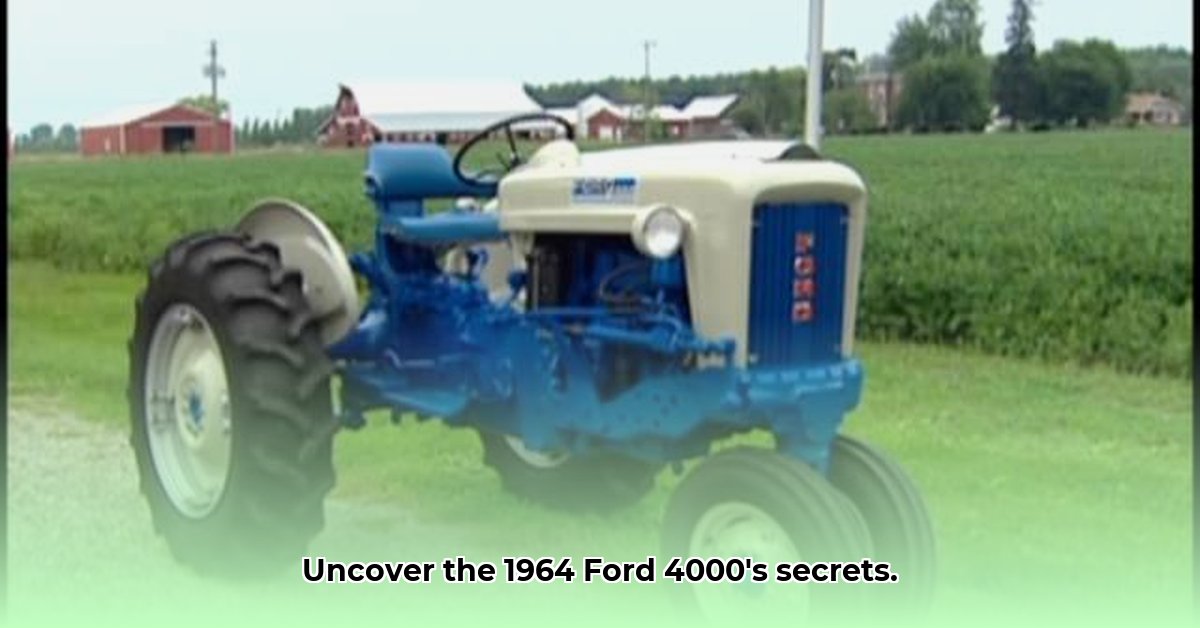
Engine Specifications: Power Options and Performance
The 1964 Ford 4000 offered a robust 2.8-liter four-cylinder engine available in gasoline, diesel, or liquid propane gas (LPG) configurations. This choice provided farmers with flexibility based on fuel preference and cost. While the advertised gross engine power was 62.5 hp, it's crucial to differentiate this from the more practical drawbar horsepower (DHP) and power takeoff (PTO) horsepower. DHP represents the power available for pulling implements like plows, while PTO horsepower powers implements connected to the tractor's PTO shaft, such as a hay baler. DHP and PTO horsepower figures are typically lower than the gross engine power, reflecting real-world operating conditions. For instance, a steep incline significantly reduces the effective drawbar power. The exact DHP and PTO horsepower for each fuel type varied slightly; diesel engines generally delivered superior torque. For more information on Ford tractors, check out this helpful resource.
Transmission and Drivetrain: Gear Options and Functionality
The Ford 4000 offered various transmission options catering to different farming needs and preferences. Configurations ranged from simpler four-speed to more sophisticated twelve-speed full power shift transmissions. The choice of transmission directly affected both operational efficiency and the tractor's ability to handle various tasks and terrains. A twelve-speed transmission allowed for finer control over speed and power, optimizing performance for diverse applications. Understanding the specific transmission fitted to an individual tractor is essential for determining its operational capabilities.
Hydraulic System: Lifting Capacity and Fluid Flow
The Ford 4000's hydraulic system, pivotal for operating implements via the three-point hitch, featured a 5.4 gallons per minute (gpm) pump. This provided the necessary power to lift and control implements. The tractor's rear lift capacity was a substantial 2360 pounds (1070 kg), allowing it to handle a wide range of agricultural equipment effectively. This substantial lift capacity contributed significantly to the tractor's overall versatility.
Other Key Features: Steering, Brakes, and Attachments
Beyond the core powertrain and hydraulics, several other features contributed to the Ford 4000's effectiveness. These included the steering system (known for its responsiveness and ease of use), the braking system (vital for safe operation, especially on inclines), and the overall versatility in terms of compatible attachments. The three-point hitch system, commonplace on tractors of this era, facilitated the easy connection and operation of a broad array of implements designed to perform various agricultural tasks. The availability and cost of these attachments remain a factor for prospective owners.
Historical Context: The Ford 4000 in the 1960s Agricultural Landscape
The 1964 Ford 4000 played a significant role in the mechanization of agriculture during the 1960s. It was a pivotal model in Ford's tractor lineup at that time, directly competing with other major manufacturers like John Deere and Massey Ferguson. While precise comparative data on market share is limited, the Ford 4000’s success is evident in its lasting legacy. Its reputation for reliability and versatility cemented its place among the leading agricultural tractors of its time, contributing substantially to the increased efficiency and productivity witnessed in farming during that period.
Maintenance and Restoration: Practical Considerations for Owners
Maintaining and restoring a 1964 Ford 4000 requires a commitment to both mechanical knowledge and resourcefulness. While certain components may become difficult to source over time, dedicated online communities and specialized parts suppliers offer valuable resources for owners. Regular maintenance, including routine inspections, fluid changes, and preventative repairs, is crucial to prolonging the tractor's lifespan. A serious restoration project demands significant time, expertise, or professional assistance. However, the effort frequently results in a beautifully restored, fully functional tractor with lasting value.
Key Takeaways:
- The Ford 4000's versatility stemmed from its engine options (gasoline, diesel, LPG), multiple transmission choices, and substantial lifting capacity.
- Understanding the differences between gross, drawbar, and PTO horsepower is critical for assessing real-world performance.
- Maintaining and restoring a Ford 4000 requires dedication and access to specialized parts and resources.